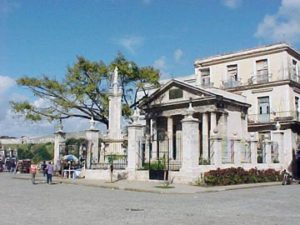On November 16, 1519, according to tradition, the first Mass and the first town hall were celebrated on an original silver planted with the same species when, on that date, Havana settled in its place since then.
The original ceiba that on the northwest side of what would be the Plaza de Armas saw, prostrate under its shadow, those valiant colonizers and who was for decades a unique witness of a historical fact and also religious and poetic, had to be replaced opportunely to Over time.
In just one year the new ceiba of El Templete was in its place. The tree of 15 years, planted in the same point where the Villa of San Cristóbal of Havana was founded, did not survive the conditions of its new location. It came to replace a legendary ceiba, but it dried to a stout trunk without a single leaf in its branches.
This Thursday, finally, the local authorities have removed what was left of the young copy. In its place there is only now an immense hollow surrounded by earth removed that the habaneros look with resignation and the tourists with curiosity.
In its place there is only now an immense hollow surrounded by earth removed that the habaneros look with resignation and the tourists with curiosity.
Since the 497th anniversary of the founding of the city was celebrated last year, attendees perceived its hasty deterioration. During the realization of the traditional round around the tree that takes place every November 16 at midnight, several assistants noticed that she was “more dead than alive”.
The previous ceiba had found its end because of the comminuted that devoured inside, but this one never got to “catch well” in the place, according to a newspaper seller who offers its merchandise in the Place of Arms.
The Cuban capital has remained without one of its National symbols.
Agencies / 14ymedio / Extractos / Internet Photos / Arnoldo Varona / TheCubanHistory.com
THE CUBAN HISTORY, HOLLYWOOD.
FOLLOW US ON TWITTER AND FACEBOOK. THECUBANHISTORY.COM

MUERE OTRO SÍMBOLO NACIONAL, LA CEIBA DEL TEMPLETE.
Bajo una original plata sembrada de la misma especie se celebró, el 16 de noviembre de 1519, según la tradición, la primera misa y el primer cabildo cuando, en esa fecha, La Habana se asentó en el lugar que ocupa desde entonces.
La ceiba original que en el lado noroeste de lo que sería la Plaza de Armas vio, postrados bajo su sombra, a aquellos valerosos colonizadores y que fue durante décadas testigo único de un hecho histórico y también religioso y poético, debió ser reemplazada oportunamente a lo largo del tiempo.
Apenas un año estuvo en su lugar la nueva ceiba de El Templete. El árbol de 15 años, sembrado en el mismo punto donde se fundó la Villa de San Cristóbal de La Habana, no sobrevivió a las condiciones de su nuevo emplazamiento. Llegó para sustituir a una ceiba legendaria, pero se fue secando hasta convertirse en un escuálido tronco sin una sola hoja en sus ramas.
Este jueves, finalmente, las autoridades locales han removido lo que quedaba del joven ejemplar. En su lugar solo se ve ahora un inmenso hueco rodeado de tierra removida que los habaneros miran con resignación y los turistas con curiosidad.
En su lugar solo se ve ahora un inmenso hueco rodeado de tierra removida que los habaneros miran con resignación y los turistas con curiosidad.
Desde que el pasado año se celebró el aniversario 497 de la fundación de la ciudad, los asistentes percibieron su apresurado deterioro. Durante la realización de la tradicional vuelta alrededor del árbol que se hace cada 16 de noviembre a medianoche, varios asistentes notaron que estaba “más muerta que viva”.
La anterior ceiba había encontrado su final a causa del comején que la devoró por dentro, pero ésta nunca llegó a “prender bien” en el lugar, según cuenta un vendedor de periódicos que ofrece su mercancía en la Plaza de Armas.
La capital cubana se ha quedado nuevamente sin uno de sus símbolos.
Agencies/14ymedio/Extractos/Internet Photos/Arnoldo Varona/TheCubanHistory.com
THE CUBAN HISTORY, HOLLYWOOD.








